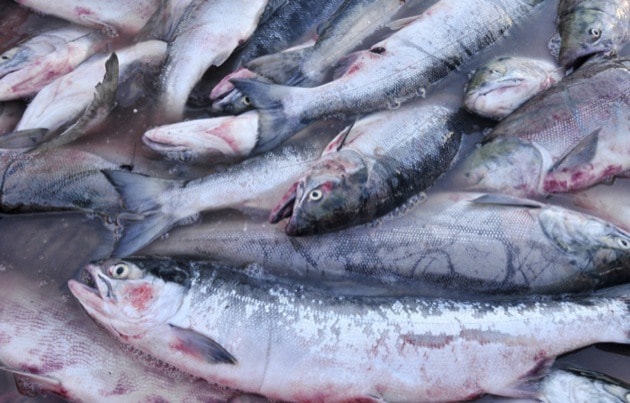A substantial increase in conservation and protection officers from the Department of Fisheries and Oceans (DFO) in early August has caused some fishermen to call foul in Prince Rupert.
Stemming from an incident on Aug. 2, allegedly involving four to five fishermen and at least two DFO officers, a tense confrontation led the department to ramp up the presence of officers at the Canfisco Oceanview plant throughout the following eight to 10 days.
“[The officers] went out and they encountered a lot of non-compliance with some of the regulatory pieces in the same fishery that was open and the one we were concerned about was what we call ramping (seine net hauled aboard en masse, causing fish to be crushed) [versus] brailing their catch, using a smaller net to lift the fish out of the bigger seine net,” said Tom Hlavac, acting regional director for conservation and protection Pacific Region last week.
The incident allegedly involved some angry and agitated fishermen yelling at an officer who had boarded a vessel to inspect the boat for regulatory compliance (something the officers don’t need permission to do), but encountered resistance not by the vessel’s owner, but by other fishermen in the area.
After a heated exchange between the fishermen and an officer stationed nearby, the officers disengaged from the vessel. One of the officers looked frightened and aggressive, said Joy Thorkelson, northern representative for United Fishermen and Allied Workers’ Union (UFAWU-Unifor), who was at the scene by chance and said she tried to diffuse the situation.
“We stopped exerting our authority and we disengaged because we didn’t want to get hurt. When you’ve got several hostile fishermen yelling at you, it’s almost a schooling behaviour. It’s almost a mob mentality. It’s just fish, it’s not worth getting hurt for,” said Hlavac.
The DFO then delayed the opening of the gillnetting fishery because it brought in additional officers from the south coast and Haida Gwaii, something which also upset area fishermen.
At its peak on approximately Aug. 5, there were as many as 17 officers at the offloading location in Prince Rupert.
Hlavac suspected that a number of factors went into the fishermen’s frustrations last week, including constantly changing regulations from year to year over restrictive fishing methods and species of fish, particularly sockeye salmon and other salmon species, as well as allowing different user groups to have a chance at the fish down the coast.
The restrictions are in place to make sure that different geographic locations, as well as industry, community and First Nations groups are all able fish fairly. However, in a UFAWU-Unifor bulletin distributed July 29, the union took exception to DFO officials seizing non-retention sockeye and chum and charging fishermen for possessing some of the fish, some of which had been used as food fish for First Nations communities when fishermen discovered that the salmon had been dead in their bycatch.
“C and P (conservation and protection) is charging fishermen for having a small amount of bycatch by accident or for food reasons making fishermen into criminals,” read the bulletin.
But seine fleets have the tools to handle the new regulations, said Hlavac.
“I’m being told close to 66 per cent of the vessels were ramping, so it was a very important piece we want to see compliance with to have a sustainable fishery. That’s why we started doing some harder enforcement,” said the regional director, adding that seiners are capable of catching whole schools of fish, whereas sport fisherman, are only catching one at a time – a sore point for some fishermen who find it nonsensical to allow sport fishermen to have full bag limits on salmon while commercial fleets must release them, as outlined in the bulletin. Hlavac said it’s important to remember that sport fishermen catch fish one at a time and not in entire netting networks.
“We did see what I would call more minor violations, so failures in the hail-outs and hail-ins. Because we were a bit stricter, our tolerance for minor mistakes was a lot lower than it normally would be. We’re happy to issue warnings in a normal season to help fishermen,” said Hlavac.
“This is one of the first times we’ve forced people to be compliant in a long time.”
UFAWU-Unifor maintains in its bulletin that the current climate of releasing salmon for seine fleets is unsustainable.
“DFO now manages many systems so that escapement has to be met before any fishing can take place, leading to over-escapement and negative impacts on future generations of salmon,” it read.
Hlavac said he would be happy and open to dialogue on policy changes, including allowing a small quantity of sockeye to be kept accidentally by seine nets, but stated any changes would most likely have to take effect next season, if any were made, due to the decisions in a timely manner required behind the Integrated Fisheries Management Plan and bureaucratic red tape.
Currently, no non-retention salmon are allowed to be caught.
